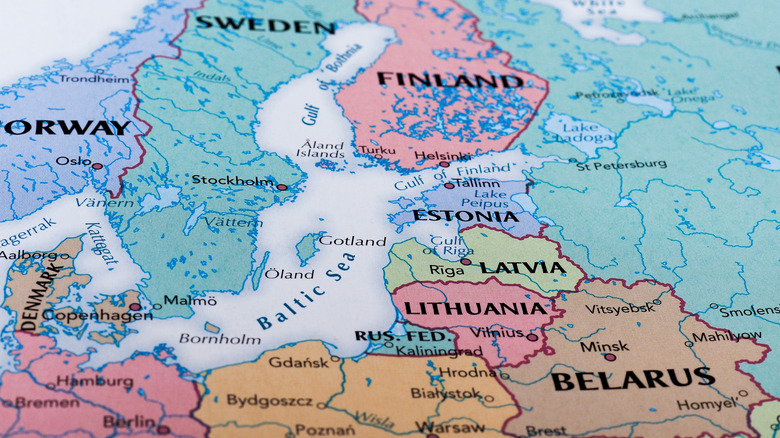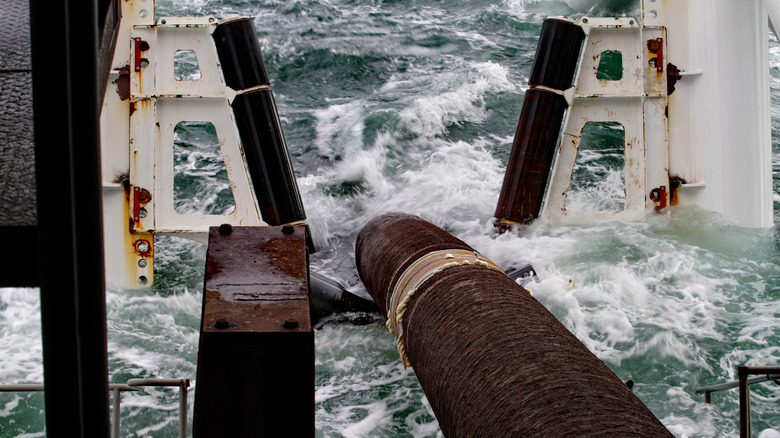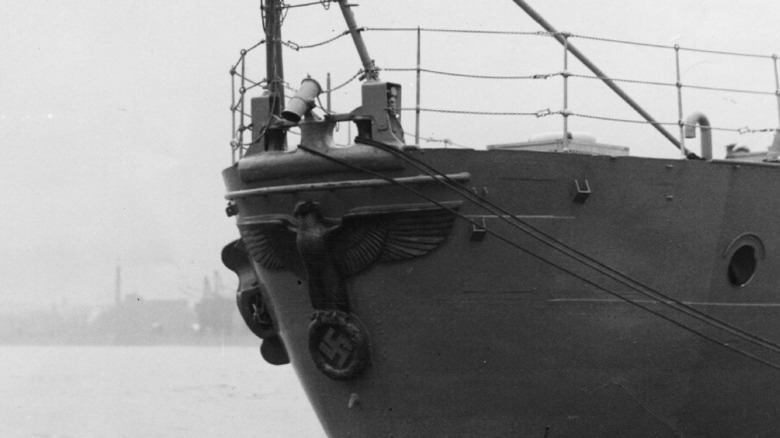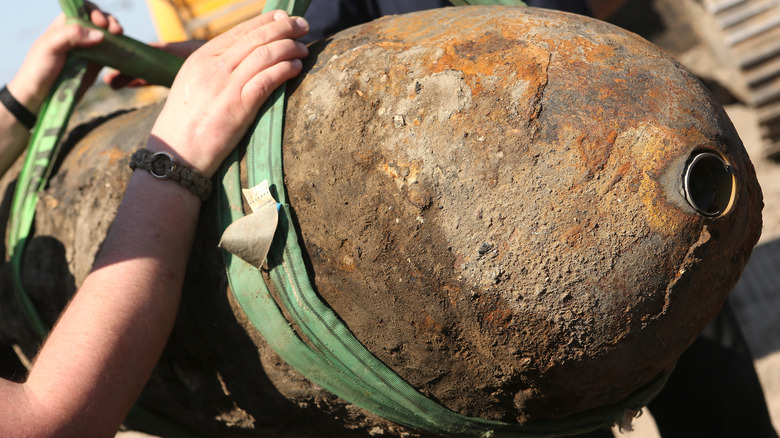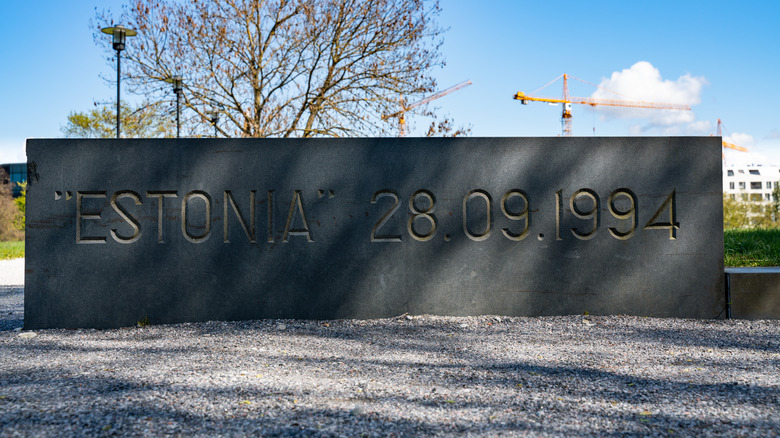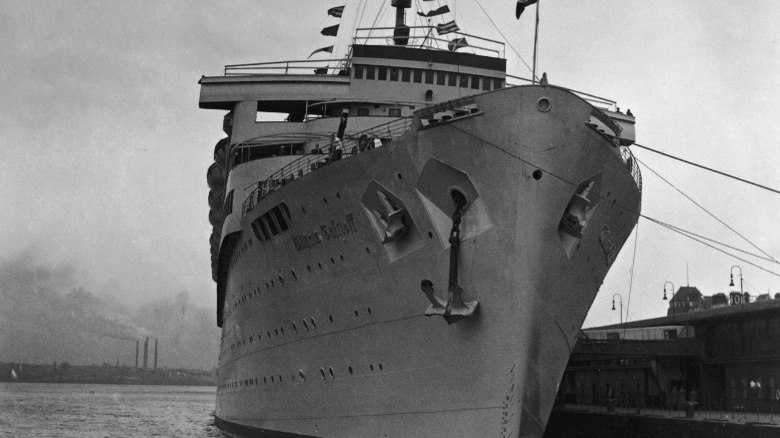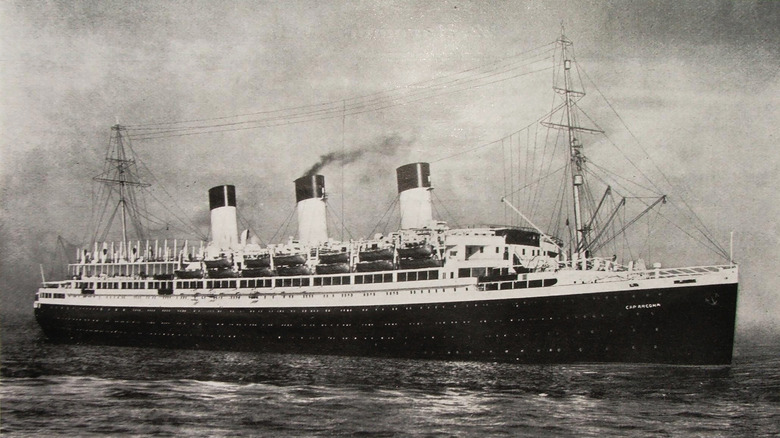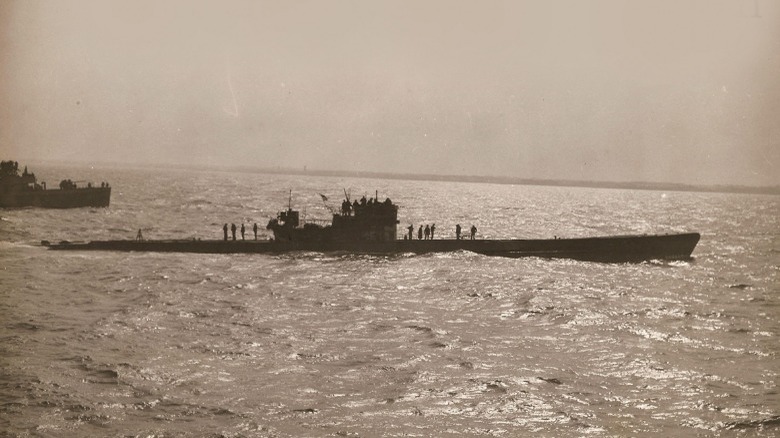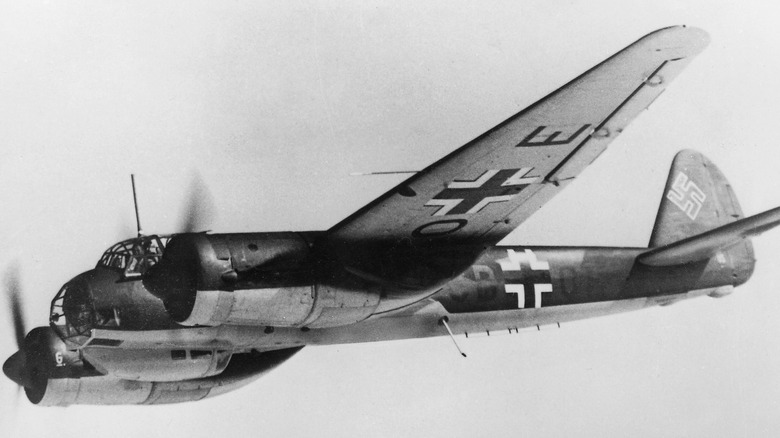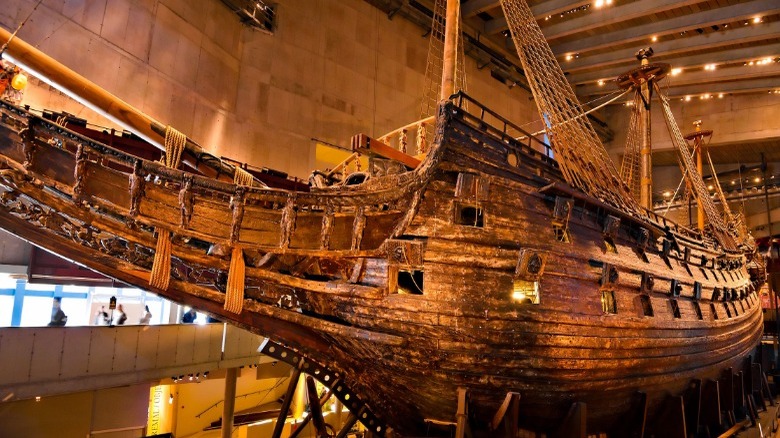Things Found At The Bottom Of The Baltic Sea
An arm of the Atlantic Ocean, the Baltic Sea is the largest body of brackish water in the world, bordering Denmark, Sweden, Germany, Poland, Russia, Lithuania, Latvia, Estonia, and Finland (via Britannica). Covering some 149,000 square miles, the Baltic has a relatively low average depth of 180 feet, although it reaches over 1,500 feet at its deepest point, according to Marine Finland.
While it may not be as large as the Mediterranean or as oil-rich as the North Sea, the Baltic has been a hub of activity for centuries. Its strategic and mercantile value has made the Baltic Sea a vital waterway since at least the Roman period, through the middle ages and right up to the present day, meaning that a lot of history has occurred on the Baltic's harsh, icy waters, and numerous objects have slipped beneath the waves, from medieval vessels and Nazi U-boats to Russian pipelines, as well as those unidentified bits of mystery.
Amber
According to the Royal Society, the Baltic Sea is home to the largest amber deposits in the world. Shards of amber often wash up on the Baltic shoreline, especially in Kaliningrad, Russia, which exports 90% of the world's amber. In January 2015, the BBC reported that a storm had covered Kaliningrad beaches with the fossilized tree resin, causing locals of all ages to brave the rough waves and collect private stashes, which can sell for as much as $60 per gram, according to Tech Featured.
Perhaps the most famous use of Baltic amber was in the construction of the Amber Room. Fitted with large amber panels and other ornate details, the elaborate structure was made for King Frederick I of Prussia in Danzig, which is now called Gdansk, a city in Poland. In 1716, the Amber Room was given to Czar Peter I of Russia, who placed it in St. Petersburg's Catherine Place, where it remained until 1941, when the German Wehrmacht stole it during the invasion of the Soviet Union. The panels of the original Amber Room are yet to be recovered, so the Soviet Union commissioned a painstaking replica in 1979, which was finished some 24 years later, in 2003 (via the Gemological Institute of America).
Nord Stream 2 pipeline
The controversial Nord Stream 2 pipeline runs 765 miles along the Baltic Sea floor, connecting Russian gas with Germany and Europe. Designed to double the flow of gas to Germany and Europe, construction of the pipeline began in 2018 and was completed in September 2021, at a cost of some $11 billion (via CNBC).
It was a massive undertaking. According to Practical Engineering, the project called for extensive underwater surveys to locate the best route for Nord Stream 2, as the pipeline risked disrupting fisheries, causing excessive underwater noise, and striking shipwrecks and unexploded bombs. However, the biggest problem was political. The United States long opposed the project, with both Democrats and Republicans citing the risks of Europe depending on Russian energy. Yet Germany's then-chancellor, Angela Merkel, defied international backlash and declared (per Politico), "We cannot — as some have demanded — get out of nuclear power and coal and then withdraw from natural gas as fast as possible ... that's not going to be possible."
The issue came to a head in February 2022, when Russia formally recognized breakaway regions in eastern Ukraine, which it then invaded. Independent reported that the pipeline, which was being assessed by European regulators at the time, was to be blocked by Chancellor Olaf Scholz, who said, "Now it's up to the international community to react to this one-sided, incomprehensible, and unjustified action by the Russian president."
SS Karlsruhe, a Nazi steamship still filled with cargo
The SS Karlsruhe was a cargo ship involved in Operation Hannibal, an evacuation mission that "dwarfed Dunkirk," according to historian Nick Hewitt, writing at History Extra. Led by Admiral Karl Doentiz, Operation Hannibal was launched in January 1945 to avoid total destruction by the Soviet Union, which was storming toward Prussia and Berlin. Much like Dunkirk, which was the Anglo-French evacuation in May 1940, German forces used any vessels they could find to carry hordes of injured soldiers and refugees. Vessels ranging from cruise ships to fishing boats worked frantically to evacuate some 900,000 German civilians and 350,000 soldiers, but not all were so fortunate (via History Hit).
In April, during the operation's fourth month, the Karlsruhe departed Pillau bound for Copenhagen. Carrying 1,083 passengers and a substantial miscellaneous load, Russian submarines torpedoed the ship dozens of miles off the Polish coast, sending it to the sea floor and killing 970 people. Over 75 years later, in October 2020, CBS reported that a team of Polish divers located the wreck at a depth of 290 feet. Among the wreckage were vehicles, china, and dozens of chests, all in good condition.
Bombs and other hazardous weapons
Another relic of the First and Second World Wars, bombs are scattered along the Baltic sea floor. Euronews cites Oliver Kinast of the Schleswig-Holstein bomb disposal unit, who says that the Baltic and the North Sea contain 1.6 million tonnes of munitions. This vast carpet of bombs does not pose an immediate threat, although it is possible for anchors to cause detonation. The real concern is corrosion, which damages casings and releases harmful chemicals into the environment.
Not all of the weapons on the Baltic floor were dropped in combat. In 1961, years after the end of World War II, large reserves of chemical weapons were dumped five miles off the Lübeck coast. In the ensuing 61 years, over 5,000 gallons of bottled poisons such as chloric gas and laughing gas have dispersed across the seabed. Oceanographer Stefan Nehring said, "If one of these bottles breaks, thousands of liters of chloric gas will be released into the ocean, which could kill anyone in the immediate surroundings ... Even from a distance of 300 meters, these chemicals pose serious health risks to humans."
MS Estonia
In 1994, the MS Estonia passenger ferry sank off the coast of Uto Island, Finland, resting at a depth of some 260 feet. The catastrophe, which occurred during a route from Tallinn to Stockholm, killed 852 people, causing it to be among the worst peacetime disasters in maritime history (via Euronews). A 1997 investigation conducted by Estonia, Finland, and Sweden found that the disaster started when the bow door locks failed to open during a severe storm, causing serious flooding.
However, in 2020, Euronews also reported that a pair of Swedish documentarians found several holes in the ship's hull, casting doubt over the official version of events. Their investigation, which was conducted with a remote-controlled submarine, was faced with legal action, as the wreck is classed as a graveyard that must not be disturbed. Nevertheless, the documentary caused another official report, which determined that the holes were too small to have sunk the Estonia in one hour. Swedish investigator Jonas Bäckstrand concluded that the newly discovered damage was likely caused by hard contact with the seabed, which was found to be unusually rocky.
The Baltic Sea Anomaly
Eleven years ago, in June 2011 (per Live Science), a team of Swedish divers produced a sonar image of a strange object resembling the Millennium Falcon (via Expressen). The "Ocean X" team located the object in the Gulf of Bothnia, which separates Sweden and Finland in the northern Baltic Sea.
Ocean X leader Peter Lindberg said, "You see a lot of weird stuff in this job but during my 18 years as a professional, I have never seen anything like this ... If this is Atlantis, that would be quite amazing" (via Gizmodo). After another visit to the anomaly, Linderberg claimed to have found an entrance on top of it, adding that it was surrounded by charred, sooty rocks, suggesting that these were the detritus of entry into Earth's atmosphere.
As news of the anomaly gained media traction around the world, experts were quick to dismiss Lindberg's talk of Atlantis. Scientist Katherine Croff Bell said (per Live Science), "In contrast to rocks found on land, practically all rocks that have been underwater for a long time are black, so their color doesn't necessarily indicate volcanic or burned origin." Dan Fonari, marine geologist at the Woods Hole Oceanographic Institution, was equally dubious: "I would not place too much confidence in any interpretation until a better processing is done and the details of the type of sonar and particulars are provided ... the whole thing is pretty unbelievable, frankly."
MV Wilhelm Gustloff
Another casualty of Operation Hannibal, the sinking of the MV Wilhelm Gustloff in January 1945, was the worst maritime disaster in history. The ship had been seldom used, which caused Captain Friedrich Petersen to go no faster than 12 knots (14mph) in order to avoid engine failure. This sluggish speed gave an advantage to Russian submarines patrolling the area, such as the S-13 model commanded by Captain Aleksandr Marinesko, who began to hone in on the Gustloff at 7 p.m. At 9:15 p.m., the Gustloff was struck by three of Marinesko's torpedoes, sending it to the seabed in just 60 minutes (via Britannica).
The loss of life was diabolical. Some 9,000 people died, the majority of them civilians. There was also a sizeable military element on board, with at least 1,000 personnel and significant military equipment. The sinking of the Gustloff killed almost three times as many people as the disasters of the Titanic, the Lusitania, and the USS Arizona combined.
The wreck has been visited by several diving expeditions, including Mike Hunter from "The Sea Hunters" TV documentary. In a clip posted to YouTube, Hunter said that "We were seeing a part of the ship that was very much like it was on the night that it sank ... we were caught up in a sense of eerieness, you could only see what your light could illuminate."
SS Cap Arcona
Yet another maritime tragedy of the Second World War occurred in May 1945, when the RAF sank the SS Cap Arcona, killing thousands of concentration camp victims (via The Conversation). Adolf Hitler had died just days prior when the Cap Arcona traveled out of the Bay of Lubeck in the Baltic Sea. The British were informed that the ship was carrying members of the SS, and this proved to be true. However, according to The National, these individuals were far outnumbered by the scores of concentration camp survivors who may have thought that their suffering was finally over.
Armed with this incomplete intelligence, five squadrons of Hawker Typhoon fighter bombers approached the Cap Arcona as she left the German coast. Commander Derek Stevenson remembered, "We had been in action for days blowing up railways, refineries, and ships. For us, this was just another job, but knowing the SS were on board made us all the more determined to destroy the ships. We came in at 9,000 feet, dived to 3,000 feet and I fired all eight rockets and every cannon round at one ship."
The SS Cap Arcona was decimated by this heavy fire, plunging it into the Baltic's icy waters. When it became clear that thousands of innocent victims had died, the British ordered the local German population to dig mass graves for them. Flight lieutenant David Ince, one of the Typhoon pilots, said later, "If you are in war, then these things happen. You try yourself to stop them happening ... But try as you will, you cannot stop it" (via The National).
Many submarines
The Baltic Sea is home to many shipwrecks. According to German maritime expert Thomas Dehling (quoted by Deutsche Welle), there are about 1,000 shipwrecks in German Baltic waters alone, which cover less than 10% of the Baltic Sea's area. One of the heaviest clusters of wrecks can be found in Gdansk Bay off the Polish coast. From 1941-1945, over 20 German U-boats were sunk in this area, many of them destroyed by British mines (via Uboat.net).
U-boats were not always sunk by the enemy. Sometimes, they were sunk through human error. On February 24, 1943, U-649 was engaged in a training session off the coast of Leba when it crashed into U-232, another German U-boat. While the U-232 survived the clash, the U-649 was so severely damaged that 35 of its crew perished. However, the U-232's luck was short-lived, as on July 9, 1943, she was destroyed in the North Atlantic Ocean with all 46 hands lost.
Decades later, in October 2020, The First News reported that a team of divers had found the wreck some 230 feet beneath the surface. Lead diver Tomasz Trojanowicz said, "The large number of submarine wrecks at the bottom of the Baltic is no surprise. It is where the largest ports were and the surrounding area is where Kriegsmarine training fleets were located."
And many planes, too
Numerous planes have crashed into the Baltic sea, many of them military. According to the Associated Press, a Junkers JU88 was pulled from the sea floor off Rugen Island by the German Military Historical Museum in June 2012. Spokesman Captain Sebastian Bangert said, "Right now there is someone who just knows that their grandfather or great grandfather went missing in the war, to give that person closure is our goal ... And for us as a history museum, the aircraft is the only way to convey the information ... the history behind it, the personnel, how did they live, what did they experience, that is what we want to tell."
Described by the RAF Museum as "the most versatile German combat aircraft in World War Two," the JU88 was used for a variety of missions, namely bombing, reconnaissance, and anti-ship actions. According to Flying Mag, the 16,000 JU88s that were built during the war have been reduced to just a handful today, so the discovery on the Baltic seafloor was an exciting occasion.
Just to the west of Rugen island, off the coast of Gedser in Denmark, there rests the wreck of a Boeing B-17G Flying Fortress (via Aviation Safety Network). The American bomber was returning from a mission over Ankum, Germany, when it was struck by flak cannon fire on August 4, 1944. The pilot managed to escape the plane as it ditched in the waves, but the other eight men in the crew perished.
Vasa, until 1961
Vasa is a 17th-century ship that sank just 1,300 meters into her maiden voyage. She remained in Stockholm harbor until 1961, when she was salvaged. Vasa is now housed in a museum and is among Sweden's most popular tourist attractions. She was built in 1627 and had impressive proportions. When Vasa was finished, she was 226 feet long and over 165 feet high. She weighed 1,200 tonnes and had 10 sails, 64 cannons, and 120 tonnes of ballast. There was, however, a problem. Captain Söfring Hansson had 30 men run up and down the deck, causing the ship to roll so badly that Söfring halted the exercise, afraid that it would sink the ship in the quay. Under pressure from the king, and against his better judgment, Söfring ordered the ship to sail.
On August 10, 1628, Vasa began her maiden voyage before a crowd of Swedes and foreign visitors. Just 4,265 feet into her journey, a gust of wind caused Vasa to tip, allowing water to gush through the gun ports. Within minutes, Vasa had sunk to the seabed 100 feet below.
Diving teams managed to visit the wreck using a rudimentary diving bell, a technology that would not become practical until the late 1700s, according to Britannica. However, they managed to salvage Vasa's cannon, which would be the last reclamation in over 300 years. In 1958, it was announced on Swedish radio that Vasa had been located in Stockholm harbor. On April 24, 1961, after years of preparation, Vasa emerged from the depths in front of a bustling international crowd.
